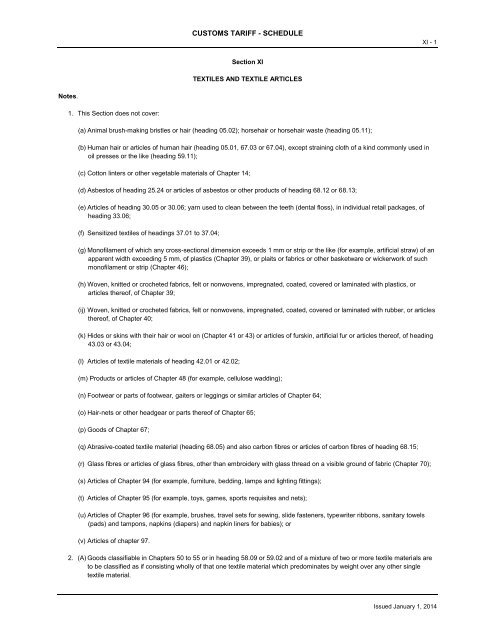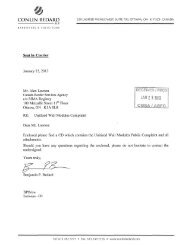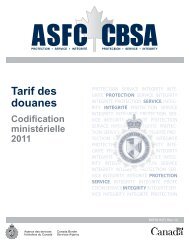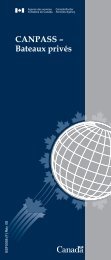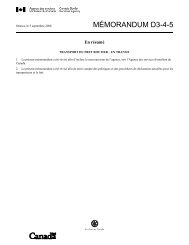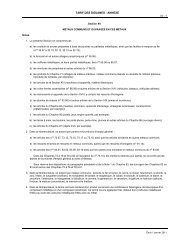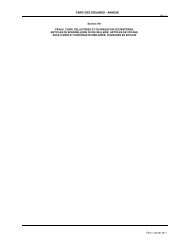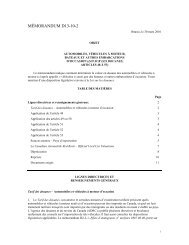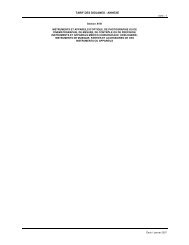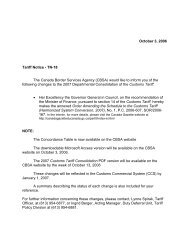Create successful ePaper yourself
Turn your PDF publications into a flip-book with our unique Google optimized e-Paper software.
CUSTOMS TARIFF - SCHEDULE<br />
XI - 1<br />
Section XI<br />
TEXTILES AND TEXTILE ARTICLES<br />
Notes.<br />
1. This Section does not cover:<br />
(a) Animal brush-making bristles or hair (heading 05.02); horsehair or horsehair waste (heading 05.11);<br />
(b) Human hair or articles of human hair (heading 05.01, 67.03 or 67.04), except straining cloth of a kind commonly used in<br />
oil presses or the like (heading 59.11);<br />
(c) Cotton linters or other vegetable materials of Chapter 14;<br />
(d) Asbestos of heading 25.24 or articles of asbestos or other products of heading 68.12 or 68.13;<br />
(e) Articles of heading 30.05 or 30.06; yarn used to clean between the teeth (dental floss), in individual retail packages, of<br />
heading 33.06;<br />
(f) Sensitized textiles of headings 37.01 to 37.04;<br />
(g) Monofilament of which any cross-sectional dimension exceeds 1 mm or strip or the like (for example, artificial straw) of an<br />
apparent width exceeding 5 mm, of plastics (Chapter 39), or plaits or fabrics or other basketware or wickerwork of such<br />
monofilament or strip (Chapter 46);<br />
(h) Woven, knitted or crocheted fabrics, felt or nonwovens, impregnated, coated, covered or laminated with plastics, or<br />
articles thereof, of Chapter 39;<br />
(ij) Woven, knitted or crocheted fabrics, felt or nonwovens, impregnated, coated, covered or laminated with rubber, or articles<br />
thereof, of Chapter 40;<br />
(k) Hides or skins with their hair or wool on (Chapter 41 or 43) or articles of furskin, artificial fur or articles thereof, of heading<br />
43.03 or 43.04;<br />
(l) Articles of textile materials of heading 42.01 or 42.02;<br />
(m) Products or articles of Chapter 48 (for example, cellulose wadding);<br />
(n) Footwear or parts of footwear, gaiters or leggings or similar articles of Chapter 64;<br />
(o) Hair-nets or other headgear or parts thereof of Chapter 65;<br />
(p) Goods of Chapter 67;<br />
(q) Abrasive-coated textile material (heading 68.05) and also carbon fibres or articles of carbon fibres of heading 68.15;<br />
(r) Glass fibres or articles of glass fibres, other than embroidery with glass thread on a visible ground of fabric (Chapter 70);<br />
(s) Articles of Chapter 94 (for example, furniture, bedding, lamps and lighting fittings);<br />
(t) Articles of Chapter 95 (for example, toys, games, sports requisites and nets);<br />
(u) Articles of Chapter 96 (for example, brushes, travel sets for sewing, slide fasteners, typewriter ribbons, sanitary towels<br />
(pads) and tampons, napkins (diapers) and napkin liners for babies); or<br />
(v) Articles of chapter 97.<br />
2. (A) Goods classifiable in Chapters 50 to 55 or in heading 58.09 or 59.02 and of a mixture of two or more textile materials are<br />
to be classified as if consisting wholly of that one textile material which predominates by weight over any other single<br />
textile material.<br />
Issued January 1, 2014
XI - 2<br />
CUSTOMS TARIFF - SCHEDULE<br />
When no one textile material predominates by weight, the goods are to be classified as if consisting wholly of that one<br />
textile material which is covered by the heading which occurs last in numerical order among those which equally merit<br />
consideration.<br />
(B) For the purpose of the above rule:<br />
(a) Gimped horsehair yarn (heading 51.10) and metallized yarn (heading 56.05) are to be treated as a single textile<br />
material the weight of which is to be taken as the aggregate of the weights of its components; for the classification of<br />
woven fabrics, metal thread is to be regarded as a textile material;<br />
(b) The choice of appropriate heading shall be effected by determining first the Chapter and then the applicable heading<br />
within that Chapter, disregarding any materials not classified in that Chapter;<br />
(c) When both Chapters 54 and 55 are involved with any other Chapter, Chapters 54 and 55 are to be treated as a<br />
single Chapter;<br />
(d) Where a Chapter or a heading refers to goods of different textile materials, such materials are to be treated as a<br />
single textile material.<br />
(C) The provisions of paragraphs (A) and (B) above apply also to the yarns referred to in Notes 3, 4, 5 or 6 below.<br />
3. (A) For the purpose of this Section, and subject to the exceptions in paragraph (B) below, yarns (single, multiple (folded)<br />
or cabled) of the following descriptions are to be treated as ''twine, cordage, ropes and cables'':<br />
(a) Of silk or waste silk, measuring more than 20,000 decitex;<br />
(b) Of man-made fibres (including yarn of two or more monofilaments of Chapter 54), measuring more than<br />
10,000 decitex;<br />
(c) Of true hemp or flax:<br />
(i) Polished or glazed, measuring 1,429 decitex or more; or<br />
(ii) Not polished or glazed, measuring more than 20,000 decitex;<br />
(d) Of coir, consisting of three or more plies;<br />
(e) Of other vegetable fibres, measuring more than 20,000 decitex; or<br />
(f) Reinforced with metal thread.<br />
(B) Exceptions:<br />
(a) Yarn of wool or other animal hair and paper yarn, other than yarn reinforced with metal thread;<br />
(b) Man-made filament tow of Chapter 55 and multifilament yarn without twist or with a twist of less than 5 turns per metre<br />
of Chapter 54;<br />
(c) Silk-worm gut of heading 50.06, and monofilaments of Chapter 54;<br />
(d) Metallized yarn of heading 56.05; yarn reinforced with metal thread is subject to paragraph (A) (f) above; and<br />
(e) Chenille yarn, gimped yarn and loop wale-yarn of heading 56.06.<br />
4. (A) For the purpose of Chapters 50, 51, 52, 54 and 55, the expression ''put up for retail sale'' in relation to yarn means,<br />
subject to the exceptions in paragraph (B) below, yarn (single, multiple (folded) or cabled) put up:<br />
(a) On cards, reels, tubes or similar supports, of a weight (including support) not exceeding:<br />
(i) 85 g in the case of silk, waste silk or man-made filament yarn; or<br />
Issued January 1, 2014
CUSTOMS TARIFF - SCHEDULE<br />
XI - 3<br />
(ii) 125 g in other cases;<br />
(b) In balls, hanks or skeins of a weight not exceeding:<br />
(i) 85 g in the case of man-made filament yarn of less than 3,000 decitex, silk or silk waste;<br />
(ii) 125 g in the case of all other yarns of less than 2,000 decitex; or<br />
(iii) 500 g in other cases;<br />
(c) In hanks or skeins comprising several smaller hanks or skeins separated by dividing threads which render them<br />
independent one of the other, each of uniform weight not exceeding:<br />
(i) 85 g in the case of silk, waste silk or man-made filament yarn; or<br />
(ii) 125 g in other cases.<br />
(B) Exceptions:<br />
(a) Single yarn of any textile material, except:<br />
(i) Single yarn of wool or fine animal hair, unbleached; and<br />
(ii) Single yarn of wool or fine animal hair, bleached, dyed or printed, measuring more than 5,000 decitex;<br />
(b) Multiple (folded) or cabled yarn, unbleached:<br />
(i) Of silk or waste silk, however put up; or<br />
(ii) Of other textile material except wool or fine animal hair, in hanks or skeins;<br />
(c) Multiple (folded) or cabled yarn of silk or waste silk, bleached, dyed or printed, measuring 133 decitex or less; and<br />
(d) Single, multiple (folded) or cabled yarn of any textile material:<br />
(i) In cross-reeled hanks or skeins; or<br />
(ii) Put up on supports or in some other manner indicating its use in the textile industry (for example, on cops, twisting<br />
mill tubes, pirns, conical bobbins or spindles, or reeled in the form of cocoons for embroidery looms).<br />
5. For the purpose of headings 52.04, 54.01 and 55.08 the expression ''sewing thread'' means multiple (folded) or cabled yarn:<br />
(a) Put up on supports (for example, reels, tubes) of a weight (including support) not exceeding 1,000 g;<br />
(b) Dressed for use as sewing thread; and<br />
(c) With a final ''Z'' twist.<br />
6. For the purpose of this Section, the expression ''high tenacity yarn'' means yarn having a tenacity, expressed in cN/tex<br />
(centinewtons per tex), greater than the following:<br />
Single yarn of nylon or other polyamides, or of polyesters...........................................60 cN/tex<br />
Multiple (folded) or cabled yarn of nylon or other polyamides, or of polyesters...........53 cN/tex<br />
Single, multiple (folded) or cabled yarn of viscose rayon.............................................27 cN/tex.<br />
7. For the purpose of this Section, the expression ''made up'' means:<br />
(a) Cut otherwise than into squares or rectangles;<br />
Issued January 1, 2014
XI - 4<br />
CUSTOMS TARIFF - SCHEDULE<br />
(b) Produced in the finished state, ready for use (or merely needing separation by cutting dividing threads) without sewing or<br />
other working (for example, certain dusters, towels, table cloths, scarf squares, blankets);<br />
(c) Cut to size and with at least one heat-sealed edge with a visibly tapered or compressed border and the other edges<br />
treated as described in any other subparagraph of this Note, but excluding fabrics the cut edges of which have been<br />
prevented from unravelling by hot cutting or by other simple means;<br />
(d) Hemmed or with rolled edges, or with a knotted fringe at any of the edges, but excluding fabrics the cut edges of which<br />
have been prevented from unravelling by whipping or by other simple means;<br />
(e) Cut to size and having undergone a process of drawn thread work;<br />
(f) Assembled by sewing, gumming or otherwise (other than piece goods consisting of two or more lengths of identical<br />
material joined end to end and piece goods composed of two or more textiles assembled in layers, whether or not<br />
padded);<br />
(g) Knitted or crocheted to shape, whether presented as separate items or in the form of a number of items in the length.<br />
8. For the purposes of Chapters 50 to 60:<br />
(a) Chapters 50 to 55 and 60 and, except where the context otherwise requires, Chapters 56 to 59 do not apply to goods<br />
made up within the meaning of Note 7 above; and<br />
(b) Chapters 50 to 55 and 60 do not apply to goods of Chapters 56 to 59.<br />
9. The woven fabrics of Chapters 50 to 55 include fabrics consisting of layers of parallel textile yarns superimposed on each<br />
other at acute or right angles. These layers are bonded at the intersections of the yarns by an adhesive or by thermal<br />
bonding.<br />
10. Elastic products consisting of textile materials combined with rubber threads are classified in this Section.<br />
11. For the purpose of this Section, the expression ''impregnated'' includes ''dipped''.<br />
12. For the purpose of this Section, the expression ''polyamides'' includes ''aramids''.<br />
13. For the purposes of this Section and, where applicable, throughout the Nomenclature, the expression ''elastomeric yarn''<br />
means filament yarn, including monofilament, of synthetic textile material, other than textured yarn, which does not break on<br />
being extended to three times its original length and which returns, after being extended to twice its original length, within a<br />
period of five minutes, to a length not greater than one and a half times its original length.<br />
14. Unless the context otherwise requires, textile garments of different headings are to be classified in their own headings even if<br />
put up in sets for retail sale. For the purposes of this Note, the expression "textile garments" means garments of headings<br />
61.01 to 61.14 and headings 62.01 to 62.11.<br />
Subheading Notes.<br />
1. In this Section and, where applicable, throughout the Nomenclature, the following expressions have the meanings hereby<br />
assigned to them:<br />
(a) Unbleached yarn<br />
Yarn which:<br />
(i) has the natural colour of its constituent fibres and has not been bleached, dyed (whether or not in the mass) or printed;<br />
or<br />
(ii) is of indeterminate colour (''grey yarn''), manufactured from garnetted stock.<br />
Issued January 1, 2014
CUSTOMS TARIFF - SCHEDULE<br />
XI - 5<br />
Such yarn may have been treated with a colourless dressing or fugitive dye (which disappears after simple washing<br />
with soap) and, in the case of man-made fibres, treated in the mass with delustring agents (for example, titanium<br />
dioxide).<br />
(b) Bleached yarn<br />
Yarn which:<br />
(i) has undergone a bleaching process, is made of bleached fibres or, unless the context otherwise requires, has been<br />
dyed white (whether or not in the mass) or treated with a white dressing;<br />
(ii) consists of a mixture of unbleached and bleached fibres; or<br />
(iii) is multiple (folded) or cabled and consists of unbleached and bleached yarns.<br />
(c) Coloured (dyed or printed) yarn<br />
Yarn which:<br />
(i) is dyed (whether or not in the mass) other than white or in a fugitive colour, or printed, or made from dyed or printed<br />
fibres;<br />
(ii) consists of a mixture of dyed fibres of different colours or of a mixture of unbleached or bleached fibres with coloured<br />
fibres (marl or mixture yarns), or is printed in one or more colours at intervals to give the impression of dots;<br />
(iii) is obtained from slivers or rovings which have been printed; or<br />
(iv) is multiple (folded) or cabled and consists of unbleached or bleached yarn and coloured yarn.<br />
The above definitions also apply, mutatis mutandis, to monofilament and to strip or the like of Chapter 54.<br />
(d) Unbleached woven fabric<br />
Woven fabric made from unbleached yarn and which has not been bleached, dyed or printed. Such fabric may have been<br />
treated with a colourless dressing or a fugitive dye.<br />
(e) Bleached woven fabric<br />
Woven fabric which:<br />
(i) has been bleached or, unless the context otherwise requires, dyed white or treated with a white dressing, in the piece;<br />
(ii) consists of bleached yarn; or<br />
(iii) consists of unbleached and bleached yarn.<br />
(f) Dyed woven fabric<br />
Woven fabric which:<br />
(i) is dyed a single uniform colour other than white (unless the context otherwise requires) or has been treated with a<br />
coloured finish other than white (unless the context otherwise requires), in the piece; or<br />
(ii) consists of coloured yarn of a single uniform colour.<br />
(g) Woven fabric of yarns of different colours<br />
Woven fabric (other than printed woven fabric) which:<br />
(i) consists of yarns of different colours or yarns of different shades of the same colour other than the natural colour of the<br />
constituent fibres);<br />
Issued January 1, 2014
XI - 6<br />
CUSTOMS TARIFF - SCHEDULE<br />
(ii) consists of unbleached or bleached yarn and coloured yarn; or<br />
(iii) consists of marl or mixture yarns.<br />
(In all cases, the yarn used in selvedges and piece ends is not taken into consideration.)<br />
(h) Printed woven fabric<br />
Woven fabric which has been printed in the piece, whether or not made from yarns of different colours.<br />
(The following are also regarded as printed woven fabrics: woven fabrics bearing designs made, for example, with a brush<br />
or spray gun, by means of transfer paper, by flocking or by the batik process.)<br />
The process of mercerization does not affect the classification of yarns or fabrics within the above categories.<br />
The definitions at (d) to (h) above apply, mutatis mutandis, to knitted or crocheted fabrics.<br />
(ij) Plain weave<br />
A fabric construction in which each yarn of the weft passes alternately over and under successive yarns of the warp and<br />
each yarn of the warp passes alternately over and under successive yarns of the weft.<br />
2. (A) Products of Chapters 56 to 63 containing two or more textile materials are to be regarded as consisting wholly<br />
of that textile material which would be selected under Note 2 to this Section for the classification of a product of<br />
Chapters 50 to 55 or of heading 58.09 consisting of the same textile materials.<br />
(B) For the application of this rule:<br />
(a) where appropriate, only the part which determines the classification under Interpretative Rule 3 shall be taken into<br />
account;<br />
(b) in the case of textile products consisting of a ground fabric and a pile or looped surface no account shall be taken of<br />
the ground fabric;<br />
(c) in the case of embroidery of heading 58.10 and goods thereof, only the ground fabric shall be taken into account.<br />
However, embroidery without visible ground, and goods thereof, shall be classified with reference to the embroidering<br />
threads alone.<br />
Supplementary Note.<br />
1. For the purposes of giving effect to Appendix 6 of Annex 300-B of Chapter Three of the North American Free Trade<br />
Agreement, goods of the tariff items contained in subheadings 5112.11, 5112.19, 5509.31, 5801.35 and 5801.36 are entitled<br />
to the United States Tariff subject to the condition set out in the Order Amending the Schedule to the Customs Tariff<br />
(Conditions for Special Provisions for the Purposes of the United States Tariff (UST)).<br />
Issued January 1, 2014
CUSTOMS TARIFF - SCHEDULE<br />
50 - i<br />
Chapter 50<br />
SILK<br />
Issued January 1, 2014
50 - 1<br />
CUSTOMS TARIFF - SCHEDULE<br />
Tariff<br />
Item SS Description of Goods Unit of<br />
Meas.<br />
MFN<br />
Tariff<br />
Applicable<br />
Preferential Tariffs<br />
5001.00.00 00 Silk-worm cocoons suitable for reeling. KGM Free LDCT, GPT, UST, MT,<br />
CIAT, CT, CRT, IT, NT,<br />
SLT, PT, COLT, JT,<br />
PAT: Free<br />
5002.00.00 00 Raw silk (not thrown). KGM Free LDCT, GPT, UST, MT,<br />
CIAT, CT, CRT, IT, NT,<br />
SLT, PT, COLT, JT,<br />
PAT: Free<br />
5003.00.00 00 Silk waste (including cocoons unsuitable for reeling, yarn waste and<br />
garnetted stock).<br />
5004.00.00 00 Silk yarn (other than yarn spun from silk waste), not put up for retail<br />
sale.<br />
KGM Free LDCT, GPT, UST, MT,<br />
CIAT, CT, CRT, IT, NT,<br />
SLT, PT, COLT, JT,<br />
PAT: Free<br />
KGM Free LDCT, GPT, UST, MT,<br />
CIAT, CT, CRT, IT, NT,<br />
SLT, PT, COLT, JT,<br />
PAT: Free<br />
5005.00.00 00 Yarn spun from silk waste, not put up for retail sale. KGM Free LDCT, GPT, UST, MT,<br />
CIAT, CT, CRT, IT, NT,<br />
SLT, PT, COLT, JT,<br />
PAT: Free<br />
5006.00.00 00 Silk yarn and yarn spun from silk waste, put up for retail sale; silk-worm<br />
gut.<br />
KGM Free LDCT, GPT, UST, MT,<br />
CIAT, CT, CRT, IT, NT,<br />
SLT, PT, COLT, JT,<br />
PAT: Free<br />
50.07 Woven fabrics of silk or of silk waste.<br />
5007.10.00 00 -Fabrics of noil silk KGM Free LDCT, GPT, UST, MT,<br />
CIAT, CT, CRT, IT, NT,<br />
SLT, PT, COLT, JT,<br />
PAT: Free<br />
5007.20.00 00 -Other fabrics, containing 85% or more by weight of silk or of silk waste<br />
other than noil silk<br />
KGM Free LDCT, GPT, UST, MT,<br />
CIAT, CT, CRT, IT, NT,<br />
SLT, PT, COLT, JT,<br />
PAT: Free<br />
5007.90.00 00 -Other fabrics KGM Free LDCT, GPT, UST, MT,<br />
CIAT, CT, CRT, IT, NT,<br />
SLT, PT, COLT, JT,<br />
PAT: Free<br />
Issued January 1, 2014


